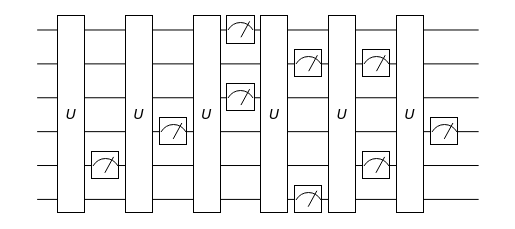Wolfram Language Paclet Repository
Community-contributed installable additions to the Wolfram Language
Chiral Fermion Random Circuit |  |

Represents a fermionic Gaussian state | |
Represents a Gaussian-type unitary operator | |
Represents a sequence of linear combinations of Majorana operators | |
Rancomd quantum circuit consisting of fermionic gates. | |
Calculates the Green's functions with respect to a Wick state | |
Calculates the entanglement entropy in a Wick state | |
Calculates the logarithmic negativity in a Wick state |

0 | - g 1 | 0 | 0 | 0 | 0 |
- g 1 | 0 | - g 2 | 0 | 0 | 0 |
0 | - g 2 | 0 | - g 1 | 0 | 0 |
0 | 0 | - g 1 | 0 | - g 2 | 0 |
0 | 0 | 0 | - g 2 | 0 | - g 1 |
0 | 0 | 0 | 0 | - g 1 | 0 |
0 | 0 | 0 | - g 1 | 0 | 0 |
0 | 0 | 0 | - g 2 | - g 1 | 0 |
0 | 0 | 0 | 0 | - g 2 | - g 1 |
- g 1 | - g 2 | 0 | 0 | 0 | 0 |
0 | - g 1 | - g 2 | 0 | 0 | 0 |
0 | 0 | - g 1 | 0 | 0 | 0 |
- g 1 | 0 | 0 |
- g 2 | - g 1 | 0 |
0 | - g 2 | - g 1 |

0 | - g 1 | 0 | 0 | 0 | 0 | … |
- g 1 | 0 | - g 2 | 0 | 0 | 0 | … |
0 | - g 2 | 0 | - g 1 | 0 | 0 | … |
0 | 0 | - g 1 | 0 | - g 2 | 0 | … |
0 | 0 | 0 | - g 2 | 0 | - g 1 | … |
0 | 0 | 0 | 0 | - g 1 | 0 | … |
… | … | … | … | … | … | … |
|
0 | - g 1 | 0 | 0 | … |
- g 1 | 0 | - g 2 | 0 | … |
0 | - g 2 | 0 | - g 1 | … |
0 | 0 | - g 1 | 0 | … |
… | … | … | … | … |
0 | 0 | 0 | 0 | … |
0 | 0 | 0 | 0 | … |
0 | 0 | 0 | 0 | … |
0 | 0 | 0 | 0 | … |
… | … | … | … | … |
|
0 | 0 | 0 | - g 1 | … |
0 | 0 | g 1 | 0 | … |
0 | - g 1 | 0 | 0 | … |
g 1 | 0 | 0 | 0 | … |
… | … | … | … | … |